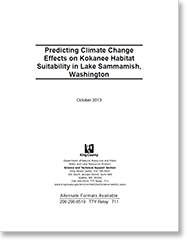Predicting Climate Change Effects on Kokanee Habitat Suitability in Lake Sammamish

Lake Sammamish becomes thermally stratified in summer with surface waters that become too warm for coldwater fish like kokanee while oxygen levels in the cold bottom waters become too low for these fish. Kokanee require suitable dissolved oxygen and temperature conditions to survive. It has been postulated that climate change (i.e., warming) could exacerbate the spatial and temporal extent of unsuitable dissolved oxygen and temperature conditions for kokanee in Lake Sammamish – the so-called temperature-dissolved oxygen squeeze. The potential effect of climate change on restoration efforts has yet to be considered, although recent research suggests that the potential success of salmon restoration efforts will be poorly characterized if climate change is not explicitly evaluated.
This report documents the ability of 2- and 3-dimensional (2-D and 3-D) lake temperature models developed as part of an earlier King County study to simulate observed lake temperatures over an 8 year period (1995-2002). The report also documents the application of these models to estimating the potential effect of climate change on lake habitat suitability for kokanee.
This report is provided in Adobe Acrobat PDF format.
Download here:
Predicting Climate Change Effects on Kokanee Habitat Suitability in Lake Sammamish (6.1 Mb)
For more information on Predicting Climate Change Effects on Kokanee Habitat Suitability in Lake Sammamish, please contact Curtis DeGasperi, Lead Hydrologist, Science Section - Hydrologic Services Group.

 Translate
Translate